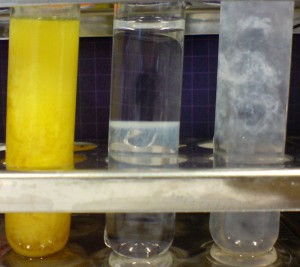Playlist
Show Playlist
Hide Playlist
Example Calculation and Summary – Other Ionic Reactions
-
Slides 02 Chemistry Advanced Le Gresley.pdf
-
Download Lecture Overview
00:00 Let’s do an example calculation. Imagine for the sake of argument, we have a one litre sample of polluted water that was analyzed for the lead(II) ion, Pb2+. By adding an excess of sodium sulphate to it, the massive lead sulphate that’s precipitated out is 229.8 milligrams. What therefore is the mass of lead in a litre of water? Express the answer as milligrams of lead per litre of solution. 00:28 So, let’s work through this. The reaction that we’re seeing, as I mentioned before, is sodium sulphate in solution plus Pb2+ in solution to give rise to 2Na+ and lead sulphate. I have left the counter anions for the lead out of the equation. But, of course, they exist either, as say, nitrates or, for example, another soluble counter anion. 00:58 First we must obtain the mass percentage of lead sulphate by dividing the molar mass of lead by the molar mass of lead sulphate and then multiply by 100. We then calculate the amount of lead in the lead sulphate that’s precipitated. 01:13 So, let’s start off. What percentage is lead as a proportion of lead sulphate? So, what we need to do is we take the overall formula mass of lead sulphate, which is the denominator in the case of this equation, and we take the mass of lead as the nominator, in this equation. Multiply by 100, this gives us the value of 68.32. This tells us that in the amount of lead sulphate that you have, 68.32% of that mass must be lead. And therefore, the amount of lead in the sample of 229.8 milligrams would involve taking 0.6832 which is the decimal of that percentage and multiplying it by the mass of lead sulphate that we precipitated out. This tells us that in one litre of our suspect solution, we have 157 milligrams of lead, which pretty much is rather unpleasant. 02:18 So, in summary, we can represent ionic RedOx equations and so forth as molecular equations, complete ionic equations or as net ionic equations where spectator ions which don’t precipitate in the reaction have been cancelled or removed. Most reactions are either precipitation reactions, acid-based reactions or oxidation reduction reactions. Acid-based reactions involve proton transfer and oxidation reactions or RedOx reactions involve the movement of electrons from one species to another. Oxidation reactions are the most important type that you’ll come across and they’re using a wide variety of different approaches not just for analytical chemistry, but also from a biological perspective as well in, for example, things like heme, in hemoglobin and also, for example, in prostaglandin synthesis. 03:17 Oxidation reduction reactions usually fall into the following categories - combination reactions, decomposition reactions, displacement reactions and combustion reactions. 03:29 Molarity, as we’ve seen, is defined as the number of moles of solute per litre of solution. 03:35 And knowing the molarity would then allow you to calculate the amount of solute in a given volume of solution. Quantitative analysis involves the determination of the amount of a species in a material. And there are a wide variety of methods for determining that.
About the Lecture
The lecture Example Calculation and Summary – Other Ionic Reactions by Adam Le Gresley, PhD is from the course Ionic Chemistry.
Included Quiz Questions
An investigator obtained 811 mg of precipitated silver chloride after adding an excess of potassium chloride to 2 liters of the sample solution. What is the mass of silver present in one liter of the sample solution?
- 305 mg of Ag per liter of sample solution
- 75.3 mg of Ag per liter of sample solution
- 610 mg of Ag per liter of sample solution
- 405 mg of Ag per liter of sample solution
- 13.3 mg of Ag per liter of sample solution
A precipitation reaction involves the formation of which of the following?
- An insoluble salt resulting from an ionic exchange reaction between two solutions containing soluble salts
- A soluble salt resulting from an ionic exchange reaction between two solutions containing insoluble salts
- A soluble salt from an ionic exchange reaction between an acid and a base
- A soluble salt from an ionic exchange reaction between a salt and an acid
- A soluble salt from an ionic exchange reaction between a salt and a base
Customer reviews
5,0 of 5 stars
| 5 Stars |
|
5 |
| 4 Stars |
|
0 |
| 3 Stars |
|
0 |
| 2 Stars |
|
0 |
| 1 Star |
|
0 |




